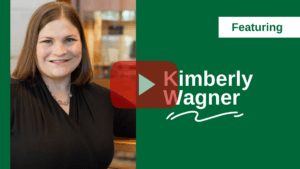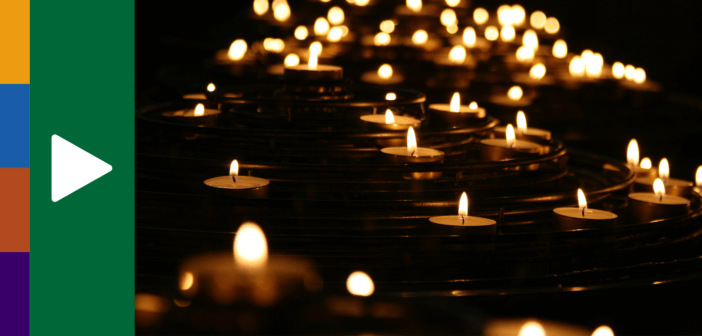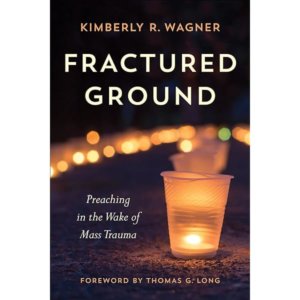
How would you preach next Sunday if tomorrow your community fell victim to a mass shooting or was devastated by a natural disaster? Preaching Professor Kimberly Wagner shares how pastors can approach this increasingly unavoidable homiletical task in ways that hold in tension the community’s very real experiences of loss and grief and the promise of God’s healing and redemption.
Listen on Apple Podcasts | Google Podcasts | Spotify
Watch on YouTube

Read in-depth interview
- Transcript — Click or Tap to Read
-
Announcer: Leading Ideas Talks is brought to you by the Lewis Center for Leadership of Wesley Theological Seminary in Washington, DC. Subscribe free to our weekly e-newsletter, Leading Ideas, at churchleadership.com/leadingideas.
Leading Ideas Talks Podcast is also brought to you by World Religions: Passionately Christian and Compassionately Interreligious, a new online course from Wesley Pathways for Ministry. You will learn how to graciously encounter and understand the various religious beliefs and practices of our neighbors. Then explore how you can think about Christian mission in such an interreligious world. The course begins February 9, 2024. Enroll now wesleypathways.com.
How would you preach next Sunday if tomorrow your community fell victim to a mass shooting or was devastated by a natural disaster? Preaching Professor Kimberly Wagner shares how pastors can approach this increasingly unavoidable homiletical task in ways that hold in tension the community’s very real experiences of loss and grief and the promise of God’s healing and redemption.
Ann Michel: Welcome to Leading Ideas Talks. My name is Ann Michel. I’m a senior consultant with the Lewis Center for Church Leadership. I’m one of the editors of Leading Ideas e-newsletter. And I’m pleased to be this host for this episode of Leading Ideas Talks. My guest today is Kim Wagner who is an assistant professor of preaching at Princeton Theological Seminary and she’s the author of a recently published book Fractured Ground: Preaching in The Wake of Mass Trauma. It is such a timely and important subject, so welcome to Leading Ideas Talks, Kim.
Kimberly Wagner: Thank you so much. It’s so good to be with you and have this conversation.
Ann Michel: In the forward to your book, Tom Long wrote: “With the proliferation of gun violence, mass shootings, pandemics, and natural disasters, sadly almost every pastor will sooner or later face the daunting task of preaching to shaken people after the sudden and surprising loss of life.” You know, no one who watches the news could disagree with the need for preachers to consider how they might prepare themselves to face this eventuality, so I get why this is such an important subject for preachers and professors of preaching. But I wanted to ask, what led you personally to take on this subject?
Kimberly Wagner: That’s such a great question. Thanks. Throughout my lives, my professional lives, I kept finding myself amid communities experiencing trauma. I have an undergraduate degree in secondary life science education and my first job was teaching tenth grade biology and eighth grade earth and space science in Cincinnati, Ohio. In the city, we had a lot of students who were experiencing trauma and poverty. A lot of gang violence was affecting our school, so I found myself teaching in that circumstance. Then I went to seminary, or as my colleagues in the middle school said, “it led me to a life of prayer.” That was their joke about seminary.
During my time in seminary, I had the opportunity to serve as a student chaplain at a maximum security women’s prison for almost two and a half years. And it deeply shaped my ministry, my life, and my questions. I found myself very much called to these communities experiencing trauma. And then when I went to the parish — I am ordained in the Presbyterian Church, U.S.A — I went to a parish in Southeast Virginia — and I thought, “I’ve had enough of these communities experiencing trauma. I’m going to go to a congregation.” Well, of course, as to be predicted, that congregation had a great deal of trauma it was dealing with before I got there. And trauma popped up in unexpected ways. For example, while I was pastoring there, the Sandy Hook shootings happened in Newtown, Connecticut, and for some of our congregants it was like it was happening in our backyard. And it took me a while to figure out what was going on. Finally, by the grace of God, I figured out that some of our folks had been deeply affected by the Virginia Tech shootings and had never talked about it and had never dealt with it. It just wasn’t something that they thought they could bring to church, right? Other issues around abuse and addiction and grief really popped up during my ministry.
So, when I went to do PhD work, I decided I wanted to think about trauma and I wanted to write a seminar paper, a 30-page paper, not very long, on preaching in response to mass shootings. When I went to look for the materials, there was nothing. There was a lot in trauma and pastoral care, trauma and psychology, that kind of stuff. But there was nothing that I could find on preaching in the wake of mass shootings. So, I did what every good PhD student does. I would complain to anyone who would listen to me, including my advisor and my peers, and they all said the same thing. “Maybe you should write it.” And I said, “That’s a terrible idea. Let’s not do that.” But the more I dug into it, the more I felt called to this work and realized how all my past experiences at the high school and the middle school and at the prison ministry really led me to be able to read this stuff and recognize my experiences in it.
So, it’s become a deep sense of call alongside it being academic work. With the book and when I teach, I hope people see both intellect and heart, right? The pastoral meets the academic and that shines through because it really does come from a pastoral space with an academic response.
Ann Michel: That’s very evident in the book which really begins by helping people understand the nature of trauma, which is extremely helpful. Before we get into your recommendations for preaching in the wake of mass trauma, you identify some less-than-helpful ways that preachers often respond to community crises. And I wonder if you could just quickly name some of those as a starting point.
Kimberly Wagner: Absolutely. So, I always want to start by saying that even when preachers respond in less-than-helpful ways they’re doing it out of a genuine sense of care and desire to help. Because none of us have been trained to teach and preach and minister in these days, right? We’re encountering trauma on trauma, often interacting and exacerbating collective traumas. I want to always start by saying I think there are less-than-helpful ways, but that oftentimes they’re done with the best of intentions.
There are three ways I think preachers are often inclined. The first way preachers are inclined is to just lament, to just throw up their hands and say, oh, my goodness! There is nothing we can say that is hopeful or good or lovely in this moment. There’s nothing faithful to say, so all I can do is just lament and just shut down this sense that there’s anything faithful to say. All we can do is cry out to God together.
That’s one end of the spectrum. The other end of the spectrum, I think, another response that folks will just default to is the opposite way — to just offer platitudes and recite all of the faith statements they’ve always said. “God’s got it.” “It’ll be okay in the sweet by-and-by.” They try to just create platitudes and almost stack faith against the pain hoping that if they can outscream the pain or outspeak it that it will be true.
Then the third way — I think this happens a lot of times — is folks ignore it. I think this is less and less an option, but historically there have been preachers who, when these situations happen, think: That doesn’t belong in church. Or I don’t even know how to begin to address this in the pulpit, so I’m not going to.
Ann Michel: It’s not in the lectionary for today.
Kimberly Wagner: Right. It wasn’t in the lectionary — I plan my sermons out. Oftentimes, I think what happens is we default to one side or the other — either all lament or all trying to stack faith language up against pain in order to silence it. Or we just kind of ignore it. I find it really fascinating when I talk to preachers who don’t want to talk about these things in the pulpit. It’s less that they don’t know what to say. Sometimes they don’t want to talk about it in the pulpit because they think it’s the elephant in the room that everybody already knows. And they are like, “I don’t want to bring that up.”
I have a student I work with in a doctor ministry program. She’s an amazing pastor and preacher. But during the pandemic their community was impacted directly by gun violence, and they lost actually a young woman in the church to a stray bullet. And when they came back together, she was really reticent to talk about this incident with the community. I mean time had passed, of course. It was the heart of the pandemic. They couldn’t gather to mourn this young woman. And I asked her why she didn’t want to talk about this young woman. She said, “We sit in a pew and hear gunshots outside the window. Gun violence is not something that we don’t think is happening.” And I asked, “But what would it mean to talk about gun violence in holy spaces or to take the sacred time of the sermon, of prayers, to name that brokenness and to add faith language to it?” And so, I think a lot of times, when folks resist it, it’s not that they don’t feel like it. It’s a fear of really wrestling with the elephant in the room.
Ann Michel: Building on what you said about some of the less-than-helpful responses, either only lamenting the problem or only giving hopeful platitudes, you say in your book that, when preaching in the wake of mass trauma, you confront the eschatological tension between what’s been broken and lost on one hand and the anticipation of God’s promised hope on the other hand. If I’m reading your book properly, I think you say that it’s a mistake to rush too quickly to the messages of hope and redemption without honestly naming the brokenness in the moment. Can you speak a bit to strike that balance?
Kimberly Wagner: Thank you so much. You’re reading it exactly right. We need to resist the urge to collapse. I talk about sitting in this eschatological tension. On one side: death, loss, brokenness. On the other side: hope, resurrection, and redemption. And I think the errors that we talked about are the tendency to collapse that tension. Now, preaching in that tension doesn’t mean right down the middle. There are times I don’t think we rush to hope and promise and resurrection, particularly in the immediate aftermath. We may find ourselves preaching over toward the death lost side, but still holding that thread of hope. I tell my students all the time that sometimes all we can hold out is the promise of hope that we have not yet experienced, right? That there’s a theology that says that hope is coming, that God is coming. I think a lot about the prophet Habakkuk standing on the rampart, lingering, and saying in the midst of the destruction of the city, “I will wait. I’m going to stand on the rampart and see what God will yet say.”
And I will often ask my preaching students after their sermon: If we were to draw this tension out, where in this tension do you think you’re preaching? How is that appropriate to where your congregation is? Because the reality is that it’s not a progression from one end to the other, right? It’s not like you start at the pain and death and lost side and gradually work your way to the hope and resurrection side. This isn’t a one-way street. I think it’s a tension we continually navigate because, as you know, anniversaries come up. Holidays come up. All of a sudden, the grief of that loss is fresh and new in very real ways. Court cases start. Another shooting happens that is reminiscent of the one-year community experience. All those things will pull your congregation back towards perhaps needing you to preach more on that death and loss side than the resurrection hope side but always holding the tension and resisting the collapse.
Enroll now in World Religions: Passionately Christian and Compassionately Interreligious, a new online course from Wesley Pathways for Ministry. You will learn how to graciously encounter and understand the various religious beliefs and practices of our neighbors. Then explore how you can think about Christian mission in such an interreligious world. The course begins February 9, 2024. Enroll now at wesleypathways.com.
Ann Michel: In your book, you explore two prototypes of how to structure a trauma response sermon. We can’t explore them in depth in this conversation, but I do want our listeners to know that in your book they will find a very thoughtful, theologically sensitive analysis of some different models for approaching the homiletical task in the face of trauma. But in both the approaches you describe, the goal isn’t to tidy everything up or make sense of everything. In both cases, it’s okay to leave some open questions.
Kimberly Wagner: That’s really helpful and a great summary of it. Early in the book, I offer the language of something called narrative fracture, which happens to communities and individuals experiencing trauma. I talk about a dual crisis of a loss of time and a loss of coherence. The stories they tell about themselves and the world and their communities and their families and even God don’t hold together anymore in time or in order. I talk about that as narrative fracture. And the book asks how do we respond faithfully to individuals and communities experiencing narrative fracture? What guides do we have for that? And I talk about preaching in the eschatological tension as the sermon content. Right? How do we position the content of our sermon?
I think it matters, too, that we honor and pay attention to narrative fracture in sermon form as well, and that’s exactly the part you were talking about. I offer two prototypes of sermon forms because, for me, it’s thinking creatively about how we preach in ways that honor, name, and bless narrative fracture without trying to resolve it too quickly — because what we want to do is say, “I can fix this. I can make these stories whole again.” We want to rush to that because it feels good and healthy and we want to get it done, right? We want to get through the process and check it off our list. But the reality is that our preaching in both its content and its form can let people who are experiencing narrative fracture know that their experience is not beyond the grace and love of God, not beyond the biblical witness, and not beyond the community. In fact, in modeling this in our preaching, in modeling narrative fracture in the ways we even put our sermons together, we can do this work of blessing. We can also do this work of modeling healthy and faithful trauma response.
Ann Michel: As I read your book, it seems you are looking at this issue primarily through a congregational care lens and that the primary audience you’re thinking about is the congregation gathered on Sunday morning, helping them reconcile a traumatic incident and their response to it with their existing belief system. But I was wondering if there isn’t a broader audience for preaching in the wake of traumatic events. I think when a crisis occurs, even in our very, very secular age, people beyond the church turn to the faith community for solace, to make meaning of it.
I’m not a working preacher, but I used to be on the staff of a big church in Washington, DC, a church that just happened to be without a senior pastor in September of 2001. And I had the responsibility of preaching in a very prominent pulpit less than two weeks after 9/11. I had never seen our church as full. And I remember thinking to myself, “Could it possibly be that Osama bin Laden is our best evangelist?” My point is this. What the church says in the face of tragedy is not just a matter of congregational care. It’s also an act of public witness. It’s a ministry to the broader community.
One of the pastors that I served under was serving a church in Dallas when Kennedy was assassinated. And just this past November when the press accounts of the sixteenth anniversary of the Kennedy death were coming out, I saw several references to his sermon and to the sermons of other Dallas preachers that day. For good or for ill, these are times when the rest of the world looks to the church and says, “What do you have to say?” So, my question is, how can someone who’s preaching in the wake of mass trauma take into account this much wider audience for their words, an audience that’s probably less theologically sophisticated and less biblically literate than their normal churchgoers?
Kimberly Brown: That’s an amazing story and bless you for that ministry. And it’s unbelievable the sermons that have come out of 9/11. I could have built the book with those sermons although some of them are hard to find because people oftentimes don’t write down the sermons they preach. It’s done almost extemporaneously. But to your question, if I could rename my book, I would rename it Fractured Ground: Proclamation in the Wake of Mass Trauma.
Ann Michel: I think it is a form of proclamation. Absolutely. It’s a form of evangelism.
Kimberly Wagner: Absolutely. For me, the audience for this book, the first row of the room, is Sunday morning preachers who have these patterns and ways of speaking that all the sudden get thrown into chaos in the wake of a mass traumatic event, right? I think that the second row is community leaders and those who have to speak into these situations. It’s very interesting. I’ve had the chance to also work with folks who do nonprofit work lately and it’s been really cool to see how that work intersects and how they have to speak to their nonprofit organizations and their communities in the wake of traumatic realities. And I actually had a gentleman who is a lawyer come to a webinar I did. And he’s said it was really helpful to him as someone working with individuals and communities who are experiencing trauma in the courtroom, right?
One of the things I did not want to lose in this book is the public witness piece and the idea that the preacher and the church and our faith still have something to say in these moments and that it is an opportunity for public witness. And I think that the preacher is called upon to model well this faithful trauma response, which we see again and again in Scripture, right? So, I do think it is an opportunity for the church. I think it is the place where the church probably gets the loudest hearing in today’s world. When literally all hell breaks loose is one of the few times that people who are not regularly in church look and ask, “Is there a word from the Lord?”
Ann Michel: And that’s an awesome responsibility. But it’s also a privilege. But it seems like we have to at least be aware of that audience and that potential.
Kimberly Wagner: Absolutely.
Ann Michel: To draw this to a close, I think one of the most important subtexts in your book is the idea that you can’t wait until a disaster or crisis happens to think about how you might preach in response to it. Beyond reading your book, are there other simple steps that you would recommend that working preachers can take to prepare themselves for the time when disaster might come to their community?
Kimberly Wagner: Absolutely. That’s such a great question. When it happens, we don’t have time, so we need to prepare. A few things to think about. The first is, as you think about your week-to-week preaching, think about using trauma lenses to look at some of these texts to practice where you see trauma at work in the text or how looking with a lens of the trauma that is going on in the world helps you see something new or different in that text, not just saying “I’m going to save all that for later” but preaching it. The other thing is, I talk about “trauma responsive” being what we do in the immediate aftermath of an incident. But there is also “trauma aware” preaching, which is being always mindful that there are those in the pews experiencing trauma, those in our communities experiencing trauma, those in the world experiencing trauma and that trauma is at work in these texts.
And, I think, practicing that with our congregation — it doesn’t have to be every week — but practicing it over and over ends up becoming language held in trust for us and for our communities for when we need it. Right? One of the things I always tell preachers is: This is not something to put on the shelf and pull out — I’m not talking about my book — but the skills are not something that you put on the shelf and pull out when you need them. You keep practicing them. Keep practicing what it means to preach in the tension and not make sure every sermon ends with a happily ever after. What does it mean to tell stories in our preaching that aren’t easily resolved? What does it mean to hold in tension some of the things that are hard to reconcile in our biblical texts, to model and to practice what it is we have to do when we encounter trauma. What does it mean to hold that eschatological tension in our day-to-day work so that we’ve exercised those muscles?
My encouragement is to think about these things. To think about your theology. A big example of when I think congregations and communities and individuals come face-to-face with a theology they don’t think about until it happens is natural disasters, right? When a natural disaster happens, people ask: So does God speak through nature? Does God correct or is God punishing us? Did God just create the world and walk away and has no control over nature? Is God just choosing not to keep us safe from storms?
The more we talk about climate crisis, the more we’re seeing these kinds of storms, people are having to contend with their theology of the relationship between God and nature and with their theology of the relationship between God, nature, and humanity. Right? And they don’t contend with that. There’s no reason to until they’re hit with a natural disaster. And then it’s important that the preacher, the pastor, the leader, faith leader have a sense of their own theology to be able to say: This is what I believe about the relationship between God and nature. Because your community is not thinking about it until it hits them. So, the second point is to nurture that theology.
The third thing that I think is so important for pastors and preachers particularly is to build communities of support, both other clergy as well as nonprofit leaders as well as other leaders in the community. I always tell my young pastors heading out, the first person you need to make friends with is the funeral director in your town because they are at the heart of it when these things happen. They are right there. Think about what it means to build a community of support because one of the lies that the trauma tells us — and it tells preachers this very loudly. Let’s be clear, when a mass traumatic event happens it’s not like the preacher can avoid it, right? If they’re in the community, they’re going to be experiencing it alongside the community. And one of the lies, one of the bad ones, that trauma whispers in our ear is that our pain is unique and we are alone and nobody can help us. I think that happens both in the recovery conversation but also happens in supporting your community. I cannot tell you how many preachers and pastors I work with who say one of the first things they realized is they felt totally alone in leading the community, that nobody can help them.
So, creating these communities of support and care and coworkers in the in-between times will help combat some of that desire to become the community superhero and the thought that you don’t have anybody to help you personally or your community. You don’t have to lead them alone. You not alone in supporting them. The last thing I’ll say may be a more general pastoral thing. Cultivate communities of support. Get connected to organizations. There are so many organizations. I name some of those resources in the back of the book. There’s more and more every day. Groups that can come in and help you and can help you support your community. So, nurturing those relationships, I think it, becomes very key.
Ann Michel: Thank you for that really good advice. This has been a fascinating conversation on such an important subject. I hope it’s going to help people to really begin to think about the importance of being prepared for this task. Again, the book is Fractured Ground: Preaching in the Wake of Mass Trauma. Thank you so much for taking the time to talk to us today and thank you for this very important work.
Kimberly Wagner: Thank you. It has been such a joy.
Announcer: Thank you for joining us for Leading Ideas Talks.
Don’t forget to subscribe to our free weekly e-newsletter, Leading Ideas, to be notified when new episodes are published. Visit churchleadership.com/leadingideas.
Fractured Ground: Preaching in the Wake of Mass Trauma (Westminster John Knox Press, 2023) by Kimberly R. Wagner is available through the publisher, Cokesbury, and Amazon.
Related Resources
- Does Your Church Need a Disaster Ministry Plan? by Jamie D. Aten and David M. Boan
- 10 Things Great Preachers Do Differently by Charley Reeb
Photo by Mike Labrum on Unsplash






